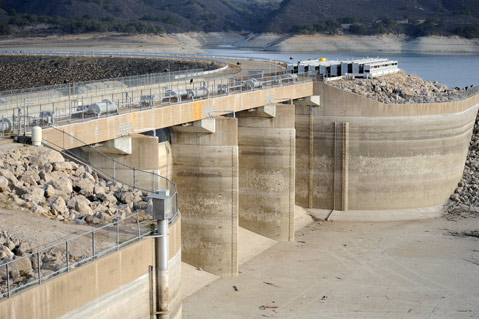Water Conservation All Wet
Voluntary Reductions Having Little Effect

Efforts by Santa Barbara City Hall to cajole voluntary reductions in water consumption have proved disappointing, generating only a 5 percent drop in the month of April. The target set by the City Council in February when it declared a Stage I drought alert was a 20 percent reduction. Water planners reported a 12 percent reduction in March, but part of that drop was due to a couple of solid downpours. Acting water czar Josh Haggmark suggested that the new water rates — which begin the month of June — should have greater impact.
Monthly water bills for high-use customers are slated to jump from $191 a month to $319, while low-use customers will experience a bump of only 81 cents. Even with the rate increase, Santa Barbara’s average monthly bill will be $10 cheaper than Montecito’s, $21 cheaper than Goleta’s, and $25 less than Carpinteria’s. Beyond that, City Hall will soon enact mandatory water-use restrictions, prohibiting residents from watering down sidewalks, operating ornamental fountains, and watering their lawns during daylight hours. It will mandate cars be washed in car washes that recycle their water and that residents use hoses with nozzles that restrict flow. First-time violations will be met with warnings. After that, maximum fines are $250 per violation. Haggmark said enforcement would be complaint driven. “We’re not going to be rolling out looking for people,” he said.
Haggmark also expressed optimism City Hall would, in fact, be able to buy additional water supplies. State regulators, he said, finally approved a deal to buy 2,000 acre-feet from rice farmers north of the San Joaquin Delta, though about 700 acre-feet of that will be lost as a carrying charge before it ever gets here. Likewise, Haggmark said he’s optimistic that the Vandenberg Air Force Base will agree to sell City Hall about 1,000 acre-feet. In previous months, such transactions were at best speculative and often problematic. If finalized, they would provide the city a much-needed cushion. Longer-term efforts to reactivate the city’s mothballed desalination plant appear more problematic, as the California Coastal Commission has expressed concern over the adequacy of City Hall’s emergency permit and whether the seawater intake approach is technologically outmoded and environmentally destructive.
Haggmark said he has scheduled two days of meetings with the Coastal Commission later this month. Rather than sucking water off the floor of the ocean, as the city’s plant did, the Coastal Commission has argued slant pipes should be drilled beneath the ocean’s floor to better protect microscopic sea life. Haggmark said previous studies showed that 100-to-200 such wells would be required given Santa Barbara’s coastal geology and that the price would be prohibitive.
Also at issue is whether the desalination plant — which cost $34 million to build in the early 1990s — should be operated only on an emergency basis or whether it should be kept running (if even at a low level) continuously to avoid the high costs of starting it up. That all depends on the frequency of need, Haggmark said. If Santa Barbara’s drought cycle accelerates to the extent the plant is needed every 12 years or less, Haggmark said, it should be kept in continuous operation. If, however, the need is not that frequent, he said it would be more cost-effective to shut it down.
Haggmark estimates it will cost $28 million to re-activate the plant and another $5 million a year to operate it. It’s little wonder, then, that the water department just transferred $4 million from its capital budget to create a water drought fund. That will be used to repair the broken Alameda Park well and to pay the $800,000 in consultants’ fees to figure out the best way to re-activate the desal plant if need be.


